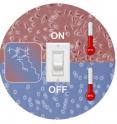Switchable bio-adhesion
What effects do new drugs have on the human body – particularly at cellular level? Can doctors administer them without risk, or do they have toxic side effects? Pharmaceutical companies carry out a variety of toxicity tests on new drugs in order to answer such questions. Cell cultures form the basis for these tests: The researchers place isolated cells in small plastic dishes, add a nutrient solution and place the dishes in an incubator heated to 37 degrees Celsius. To provide an ideal breeding ground for the cells, the dishes are made of insulating polystyrene. Once the cells have multiplied to the required number, the drug is added. However, to examine the cells' reaction to the drug, the researchers then have to remove the cultured cells from the dish. The problem is that the cells often adhere so firmly to the surface of the dish that an enzyme has to be introduced to detach them. "The cells employed in toxicity tests are particularly sensitive, and can be damaged by the added enzyme. This makes it difficult to interpret the test results. It cannot be established without doubt whether the cells' reaction to the drug has been influenced by damage caused by the method used to extract them from the dish" says Dr. Claus Duschl, department head at the Fraunhofer Institute for Biomedical Engineering IBMT in Potsdam-Golm. A possible solution is the stimuli-responsive polymer developed by a team led by Dr. Jean-François Lutz of the Fraunhofer Institute for Applied Polymer Research IAP, assisted by colleagues at the IBMT and the Max Planck Institute of Colloids and Interfaces. "At 37 degrees Celsius, the usual incubation temperature for cell cultures, this material is water-repellent (hydrophobic) – the cells feel at ease in this environment and respond by multiplying rapidly. If the substrate is cooled to 25 degrees, equivalent to room temperature, the material becomes hydrophilic (attracts water): The cells try to avoid contact with the substrate by reducing their surface area, curling up into almost spherical shapes. This enables them to be rinsed off easily, so there is no longer any need to add an enzyme," explains Lutz.
This is not the first thermoresponsive polymer. The big difference is that it is based on polyethylene glycol (PEG), which unlike other materials of this type is biocompatible. It is thus an ideal substrate for cell cultures. The new material has the added advantage of being water-soluble and non-toxic. Lutz estimates that it will be possible to mass-produce Petri dishes coated with the new property-changing polymer in about two or three years' time.
Source: Fraunhofer-Gesellschaft
Other sources
- Switchable Bio-adhesionfrom Science DailyThu, 11 Sep 2008, 2:28:23 UTC
